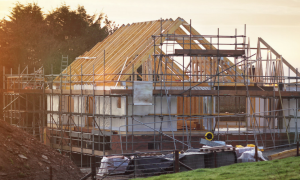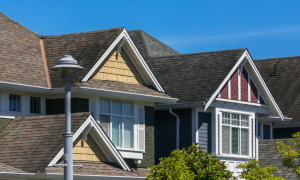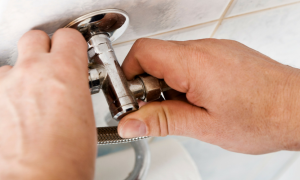The following is a guest blog post from Sonya Santos, GCP Applied Technologies
Do you know what the envelope of your home is? Just as the name “envelope” implies it is the skin of your home that protects you from the outdoor elements. The envelope of your home includes: the roof, walls and windows. These three areas are the keys to waterproofing your home. If they are built right, your home will be protected from water damage.
Now that you can speak the language to your contractor, you may be wondering how to use this information. It’s simple, go through the envelope of your home (roof, outer walls and windows) to ensure they are built with the right materials and thus watertight. If you are building a home, you will save yourself a lot of trouble and money if you build it right the first time, by using the latest innovations to protect your home from water intrusion and subsequent damage. Whether your are building a home or updating your current home, your motto should be “Don’t just build it, Protect it.”
To find out how to protect your home from water damage, follow these three steps:
1. Roof:
The complete roof system consists of multiple layers – not just the shingles. Shingles are the exterior layer, and shingles alone will not keep the water out. What makes the difference and protects your roof from water damage is the roofing underlayment, which is installed underneath the shingles. Roofing underlayments perform many functions in a roofing assembly, but first and foremost, they serve as the last line of defense between homeowners and the damaging effects of water infiltration. While use of an underlayment is required by building code, there are multiple product types that can be used. Be sure your contractor uses quality self-adhered roofing underlayments so you receive the ultimate waterproofing protection.
Requesting that your contractor use self-adhered roofing underlayments is important, especially at the eaves and at all critical detail areas. There is a wide variation in product quality and performance. GCP Applied Technologies’ Grace Ice & Water Shield® pioneered the self-adhered roofing underlayment category more than 35 years ago. Grace Ice & Water Shield® provides premium performance as it seals to itself at overlaps, seals to the roof deck and, most importantly, seals around the fasteners used to attach the shingles, which helps prevent water from leaking into your home.
2. Windows:
Windows are large openings in your home so they can definitely be major leak zones. Even if windows are well shuttered in a storm, wind-driven rain can be blown into the house at these points, especially if they have not been properly flashed and weatherproofed.
Proper selection and installation of flashing at the windows and doors is critical to the performance of your home’s weather barrier system. If not properly selected and installed, wind-driven rain, ice and snow can leak and quickly cause rot and mold in your walls. Flexible flashings such as GCP Applied Technologies’ Vycor® Plus and Vycor® PRO can be used to seal windows, doors, corners, and other non-roof detail areas. These products are designed to form a watertight and airtight seal with building materials; thus protecting your home from water damage and air infiltration.
3. Outer Walls:
As you would guess the walls of your home are pretty important! While walls may seem pretty simple to the eye, there are complex layers hidden underneath the siding of your home. It is important that the materials that comprise those layers are selected and installed properly.
You may be familiar with traditional house wraps that are used during construction or remodeling of a house, but today there is a new innovation that provides premium weather protection and is an advanced alternative to house wraps. Vycor®enV- S™ utilizes the latest in residential building science to create an air-tight, yet “breathable” home, and achieve the highest product performance available. Unlike mechanically-attached house wraps, Vycor® enV-S™ seals to itself at overlaps, seals around fasteners, and forms a strong bond with the substrate. During construction, Vycor enV-S withstands harsh weather conditions, , eliminating costly rework. And, most importantly, Vycor® enV-S™ improves the home’s energy efficiency, leading to significant savings for the homeowner.
A recent study conducted by the Oak Ridge National Laboratory (ORNL) revealed that Vycor® enV-S™ achieved an air leakage rate seven times lower than the leading house wrap brand. A reduced rate of air leakage translates to lower annual heating and cooling costs—an important benefit that homeowners will surely value and appreciate! Visit here to view an interactive map that illustrates the energy savings potential in all climate regions across the country.
By unlocking the envelope of your home and ensuring it is properly built, your home will stay dry and care-free. Check out this home waterproofing interactive guide for more guidance.
Sonya Santos is a home expert at GCP Applied Technologies, formerly known as Grace Construction Products. She has step by step tips for homeowners, contractors and builders on building homes for extreme weather.







In your article, you stated that if you are building a home, you will save yourself a lot of trouble and money if you build it right the first time, by using the latest innovations to protect your home from water intrusion and subsequent damage. My brother has been wanting to build a home on a lakefront property and his friend suggested that he should waterproof his house. I wonder if all homes can be waterproofed and if you have to waterproof each house differently.
I liked when you talked about the importance of carefully choosing the material for your walls to make sure they are waterproofed. It makes sense that understanding this can help you make sure you avoid any water damage in your home and enjoy the safety you want. I would want to make sure I consult with a professional and choose the best materials and have them properly installed din my home.
My wife is always paranoid and one of the things she has been worried about recently is our home flooding. I liked that you had mentioned that it can be very important to have the out walls waterproofed because they’re one of the most crucial parts of the home. I wouldn’t want to put the weight of this waterproofing on myself, so I might just have to look for a professional that can handle the waterproofing, especially on the walls.
I like that you mention how there are many different ways to waterproof things in your home. My brother is looking to get a waterproofing membrane but needs tips. I’ll be sure to talk to him about how he can waterproof many things in his home once he’s hired a trusted professional.